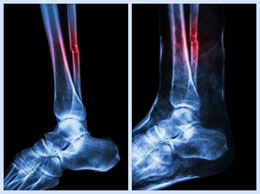The following Buzzle article deals with information about spiral fractures, their causes, and treatment.

A fracture is a medical condition in which the continuity of bones is broken. The cause of bone fracture could be an injury, or high impact stress. The different types of bone fractures are linear, oblique, transverse, complete, incomplete, spiral, Holstein-Lewis, compound, or compacted. The spiral fracture is a bit difficult to distinguish from the oblique one.
The bone fracture which occurs as a result of twisting is called spiral fracture. It is also known by the name, torsion fracture. Most of these fractures, prior to X-ray examination are confused with oblique fracture. In X-ray images the fracture may appear to be parallel to the bone axis, and the shape of fracture is similar to a corkscrew. Sports injuries are the most common cause of this. Falling off the stairs also results into such kind of fractures.
People with fragile bones are more likely to suffer from such fractures. Poor diet or age could be the reason behind the bones to become fragile. One of the best example is the twisting of leg while skiing. The feet of a skier are stuck in the ski boots which results into losing control. In the process, the legs turn, and are twisted violently. The fracture caused by such type of accidents result into excruciating pain, and one might have to stop skiing for several months.
Spiral fracture is also associated with child abuse. The fracture might be caused by the twisting or grabbing the arm, or leg of children by parents/guardians. So, if it is detected in a child, the probability is that the child is taken away by 'Children's Protective Services' while the parents are labeled as abusive, if guilty.
Spiral Fracture of Tibia and Fibula
As the leg is twisted, the body loses its balance, and the person tries to attain the position of equilibrium. It exerts pressure on the tibia and results in its cracking. In the process, the fibula also gets fractured. The tibia is broken in the lower part while the spiral fracture of fibula occurs in the upper portion of the leg. Along with tibia and fibula, spiral fracture of humerus is also common.
Treatment
The spiral/helical shape of the fracture causes delay in the treatment process. It takes a long time for the bones to heal. The time taken for spiral fracture healing, depends on factors such as location at which the fracture has occurred, the specific circumstances in which the fracture was caused and general health of the person. The treatments for dealing with fractures include surgery, or putting the affected area in a cast until it heals completely.
Surgeries are needed to put the broken bones back to their place. Internal fixation could be carried out in some cases. The process of internal fixation includes the use of pins, metal rods, etc., in the bones. External fixations are useful in keeping together the fragments of bones.


 A fracture is a medical condition in which the continuity of bones is broken. The cause of bone fracture could be an injury, or high impact stress. The different types of bone fractures are linear, oblique, transverse, complete, incomplete, spiral, Holstein-Lewis, compound, or compacted. The spiral fracture is a bit difficult to distinguish from the oblique one.
A fracture is a medical condition in which the continuity of bones is broken. The cause of bone fracture could be an injury, or high impact stress. The different types of bone fractures are linear, oblique, transverse, complete, incomplete, spiral, Holstein-Lewis, compound, or compacted. The spiral fracture is a bit difficult to distinguish from the oblique one.